What Are The Major Plants And Animals Are In Fairbanks
Disclaimer: This post may contain affiliate links. All hosted chapter links follow our editorial policies.
[Updated February 17, 2020]
My first encounter with Alaskan animals xx years ago was arguably my most memorable.
We were stopped at a light on the six-lane highway leaving Anchorage when nosotros saw a mama Moose crossing the road, with an upset calf who conspicuously had no interest in doing so. Traffic came to a standstill as the drama played out, and we cheered when the youngster finally followed.
It was the first of many incredible sightings of Alaska wildlife, which includes approximately 112 mammal species, 525 bird species, fourteen species of whales and porpoises, and 3700+ other species of marine life.
From Alaskan tundra animals (including Caribou, Wolves, and Chill Foxes) and Alaskan bears (Black, Dark-brown, and Polar) to endangered species such as Steller's Bounding main Lions and Humpback Whales, the wildlife of Alaska is thrillingly diverse.
As influential as my showtime trip to Denali National Park was on the work we do now with Green Global Travel, our recent small send Alaskan cruises with AdventureSmith Explorations were every bit impressive in terms of animal sightings.
Exploring the Kenai National Wild animals Refuge, Kenai Fjords National Park, Glacier Bay National Park, and the Within Passage, we saw more than 50 dissimilar animals that alive in Alaska.
So hither's a guide to some of the virtually intriguing Alaskan beast species, including many of our favorite wildlife images from our latest trip.
READ More: Best Small Send Cruises For Your Globe Travel Bucket Listing
ALASKAN ANIMALS GUIDE
- Alaskan Birds
- Alaskan Bears
- Other Land-Based Alaskan Animals
- Alaskan Whales & Porpoises
- Other Alaskan Marine Animals
ALASKAN BIRDS
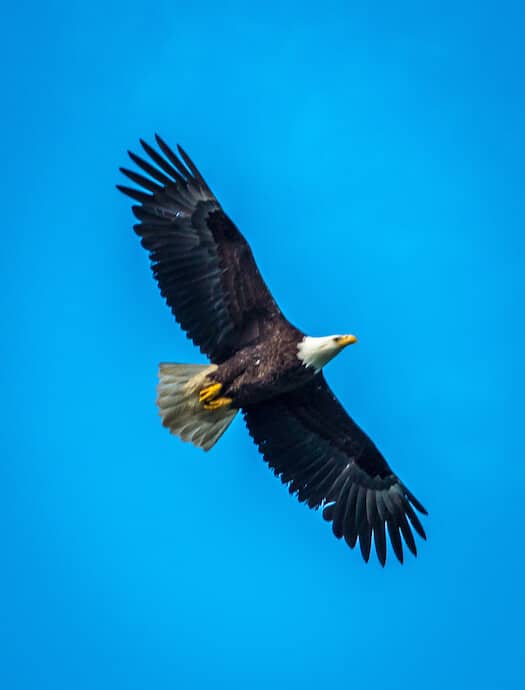
ane. AMERICAN BALD Hawkeye
Latin Name: Haliaeetus leucocephalus
Habitat: Wetlands,coasts, and marshes beyond Due north America
Size: Length: 28 to 40 in; Weight: six.half-dozen to 14 pounds
Diet: Fish, waterfowl, small mammals
Conservation Status: Least Concern, population increasing
Though the Us national bird may exist a rare sighting in the lower 48, Alaskan Bald Eagles are fairly ubiquitous.
They're found in the land'due south southern coastal areas all year-round, and along inland lakes and forests in summertime.
We saw four of these beautiful birds of prey (which can grow upwards to forty inches long) during a 3-hour raft float downwards the Kenai River, and countless others in Kenai Fjords and Glacier Bay National Park.
The by and large brownish juveniles are easily confused with Golden Eagles, as they don't get their distinctive white caput and tail feathers for iv to five years.
READ More than: List of United states National Parks by State (An Ballsy Guide)
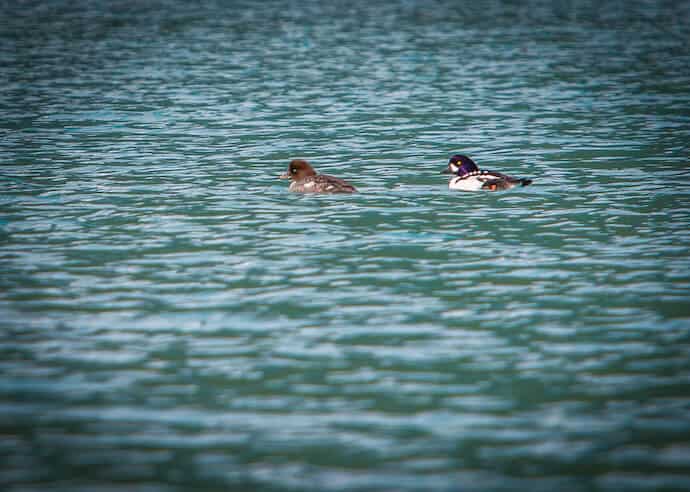
ii. BARROW'South GOLDENEYE
Latin Name: Bucephala islandica
Habitat: Shallow freshwater lakes, ponds, marine coastlines
Size: Length: xvi.9 to 19.ane in; Weight: ii.4 to iii pounds
Diet: Aquatic insects, crustaceans, mollusks, pondweeds
Conservation Status: Least Concern, population increasing
One of more than than a dozen different species of Alaskan ducks found in the state's many lakes and rivers, the Barrow'south Goldeneye rivals the Harlequin Duck among our favorite Alaskan birds.
Where the male Common Goldeneye has a gem-tone green head, the Barrow's Goldeneye is a gorgeous royal royal, with a white crescent below its xanthous eye and a black-and-white back.
Females of both species are mottled grayness, with tawny dark-brown heads. Nosotros saw this mating pair near the Pedersen Glacier in Kenai Fjords National Park.
READ MORE: twoscore Facts near the Hawaiian Goose (a.k.a.. Nene Goose)

iii. Blackness OYSTERCATCHER
Latin Name: Haematopus bachmani
Habitat: Rocky coasts and shorelines stretching forth the Pacific Coast from Alaska to Baja California
Size: Length: 16.5 to 18.5 in; Weight: 1.1 to 1.5 pounds
Diet: Mussels, limpets, shellfish, crabs
Conservation Status: Virtually Threatened, population increasing
I of Alaska's almost striking shorebirds, the Blackness Oystercatcher has an all-black torso with a long carmine neb, crimson-ringed yellow heart, and pink legs.
You'll typically find them wandering along the land's rocky seashores, where they apply their thick beak to pry and break open the shellfish they love to eat.
They can grow upwards to 18 inches tall, and have a loud, piercing whistle-similar call. Nosotros saw this side by side to the lagoon in front end of the Kenai Fjords Glacier Guild.
READ More: 15 Beautiful Birds of the Galapagos Islands
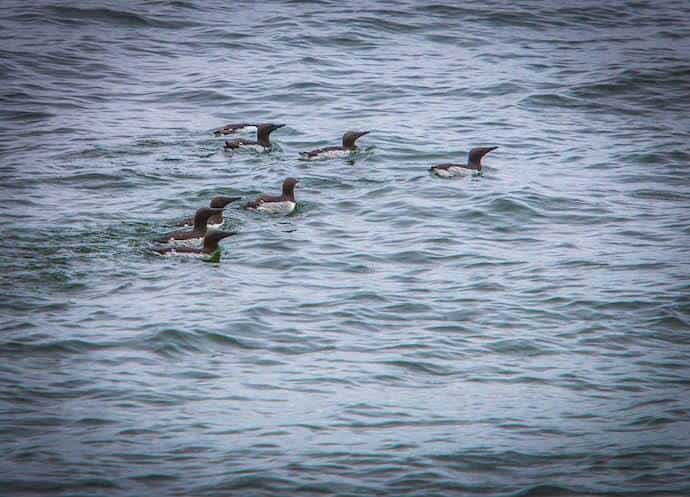
four. COMMON MURRE
Latin Name: Uria aalge
Habitat: Northern oceans, large bays about the declension
Size: Length: xv to 16.9 in; Weight: i.7 to 2.5 pounds
Diet: Fish, squid, crustaceans
Conservation Status: Least Concern, population increasing
This species' biggest claim to fame is that it is frequently mistaken for a Penguin due to its similar, tuxedo-similar coloration.
The Common Murre, which grows up to 17 inches long, is actually shaped more like a duck, but with a longer more slender beak.
During our fourth dimension in Alaska we only saw them in the open h2o, unremarkably in large groups swimming in a line or five-formation. Nosotros saw this group while cruising Alaska's Within Passage.
READ MORE:Penguins of Antarctica
v. COMMON RAVEN
Latin Proper noun: Corvus corax
Habitat: Open forests and coastal cliffs across western and northern N America
Size: Length: 22.1 to 27.2 inches; Weight: 1.v to 3.vi pounds
Nutrition: Creature matter, beetles, caterpillars, rodents, lizards
Conservation Condition: Least Concern, population increasing
Held as sacred among the indigenous Tlingit people, these humongous birds are annihilation but common when seen upward close.
Often sighted along the coast (we saw quite a few of them while walking the streets of Juneau), they tin can abound up to 27 inches long. They avowal a low, but loud croaking phone call that will definitely become your attention.
With its uniformly black feathers, shaggy head, and prominent bill, it's piece of cake to see why the Raven inspired Edgar Allen Poe's famous gothic poem.
READ MORE:ten Travel Books that Inspired My Dearest of Risk
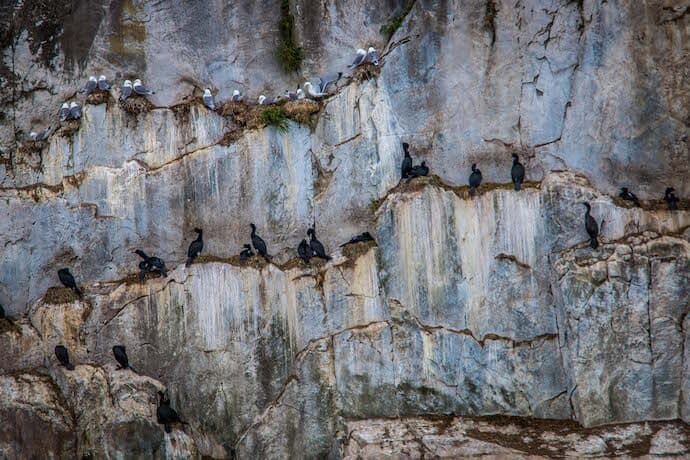
6. PELAGIC CORMORANT
Latin Name:Urile pelagicus
Habitat: Coasts, rocky bays along western North America
Size: Length: 20.1 to 29.9 in; Weight: 3 to 5.38 pounds
Nutrition: Fish, crustaceans, small fish, amphipods
Conservation Status: Least Concern, population decreasing
One of the more mutual Alaskan birds, this is one of three cormorant species found in the country. Yous'll oftentimes see their nesting colonies on the rocky ledges of coastal cliffs.
Growing up to three anxiety, the Pelagic Cormorants' crests are subtle, but can exist identified by their orangish pharynx patch, slender cervix, and hooked pecker.
You may also see them with their wings spread wide as they dry out out in the sun. Nosotros spotted these nesting in Glacier Bay National Park.
READ More than: Flightless Cormorant Mating Dance (Video)
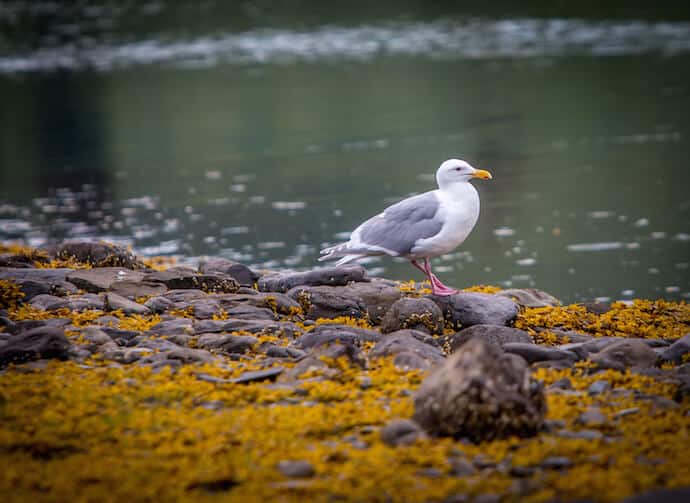
7. GULLS
Latin Proper name:Larus glaucescens
Habitat: Northern Pacific Coast
Size: Length: twenty to 27 in; Weight: 1.61 to three.73 pounds
Diet:Fish, chitons, clams, mussels, bounding main urchins
Conservation Status: To the lowest degree Concern, population increasing
In that location are at least four different Gull species usually spotted in Alaska. The most unique of these is the Bonaparte'south Dupe, which is minor and has a black head, thin bill, and reddish legs.
The most abundant is the Black-legged Kittiwake, which also has blackness-tipped wings and which you can expect to see every solar day.
Others include the Glaucous-winged Gull (which are mutual in coastal areas) and the Herring Dupe (which are usually seen near inland lakes and rivers).
READ MORE: 30 Amazing Galapagos Islands Animals
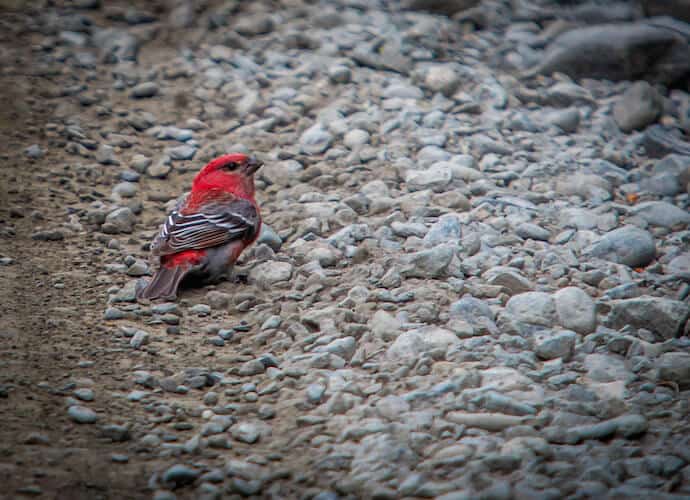
8. PINE GROSBEAK
Latin Name: Pinicola enucleator
Habitat: Coniferous forests
Size: Length: 7.9 to 9.8 in; Weight i.8 to two.eight oz
Diet: Seeds, buds, insects
Conservation Status: To the lowest degree Concern, population decreasing
This resident species' striking coloration may lead yous to mistake it for a Cardinal from a distance, but up close the Pine Grosbeak looks much more like a Finch.
Growing up to 10 inches long, the male is rosy blood-red with black wings, while the female is grey with a light-green head and rump.
Both take a black, cone-shaped bill, and are normally seen at Alaskan bird feeders all throughout the year.
We saw this handsome male feeding aslope a female on a route within the Kenai National Wild fauna Refuge.
READ More: How to Attract Birds to Your Garden
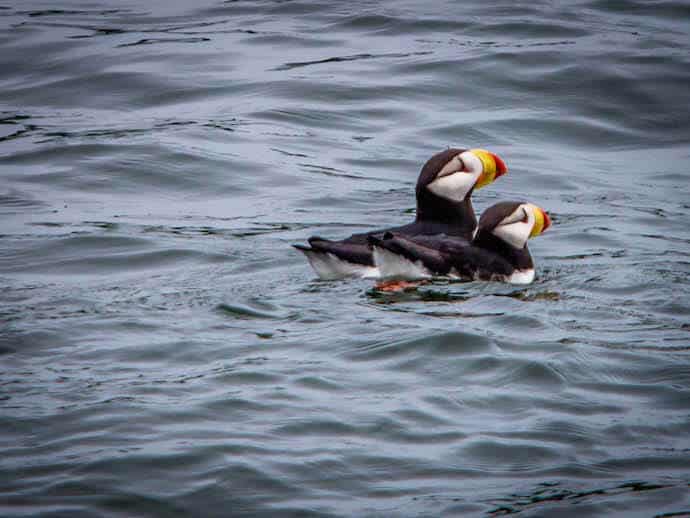
nine. PUFFINS
Latin Name: Fratercula artica
Habitat: Northern Atlantic coast during breeding season, open body of water otherwise
Size: Length: ten.2 to 11.iv in; Weight: 10.9 to 19.4 oz
Diet: Fish, crustaceans, mollusks
Conservation Condition: Vulnerable, population decreasing
There are two species of Puffins in Alaska, but they're fairly like shooting fish in a barrel to tell autonomously. The Horned Puffin has a white belly, an orange Parrot-like bill, and a distinctive black, fleshy "horn" above each eye.
The Tufted Puffin is mostly black, with long tufts of golden feathers that curl back from either side of its head.
Both are normally seen in coastal waters, where they tin "fly" underwater to feed on fish. We saw them fairly oft throughout our Alaskan cruises in both Kenai Fjords National Park and the Inside Passage.
READ More: Top 7 Things to do in Iceland

ten. Reddish-THROATED LOON
Latin Proper noun: Gavia stellata
Habitat: Arctic in tundra and taiga lakes and along marine coasts
Size: Length: 25.ii to 26.8 in; Weight: two.75 to 5.4 pounds
Diet: Fish, shrimps, mussels, frogs, insects
Conservation Condition: Least concern, decreasing
Of the five species of loons in Alaska, the Red-throated Loon is arguably the about attractive.
Its head is medium grey, with a white-flecked blackness back, vertical black-and-white stripes on its nape, and a rusty red throat patch.
Similar other loons, they tin dive upwards to 250 anxiety to hunt for fish. They typically inhabit lakes and the Arctic declension in summer, and the southern Alaska declension in winter.
We saw this mating pair in a lagoon nigh the Pederson Glacier in Kenai Fjords National Park.
READ More: xx Largest Lakes in the Globe by Continent
xi. RUFOUS HUMMINGBIRD
Latin Name: Selasphorus rufus
Habitat: Woods edges and clearings, mountain meadows
Size: Length: two.8 to iii.v in; Weight 0.1 to 0.2 oz
Diet: Nectar and insects
Conservation Status: Least Concern, population decreasing
The only ordinarily-seen species of hummingbird in Alaska, these tiny beauties nest in the southern office of the land, migrating to Mexico in winter.
Growing just 3.5 inches long, the females are greenish on top and cherry-brownish below, with a vibrant ruby-red throat patch.
You lot tin can observe them in urban areas and around flowers in alpine meadows, but nosotros had one come correct by the gunkhole during our small ship prowl of the Within Passage.
READ More than:twoscore Amazing Costa Rica Animals

12. SEMI-PALMATED PLOVER
Latin Name: Charadrius semipalmatus
Habitat: Sandy beaches, lake shores and marshes in northern N America
Size: Length: 6.vii to seven.5 in; Weight: ane.6 to one.8 oz
Nutrition: Insects, worms, crustaceans
Conservation Status: Least Business concern, population stable
Typically found along Alaska'south southern coastal areas, the Semi-palmated Plover is a beautiful brown shorebird.
They often nest along beaches, and volition become persistently vocal if you get besides close to their nesting area.
They're identified by their white throat and breast, a black ring around its neck, and a black-tipped orangish bill. They utilise the latter to probe in mud and sand in search for the invertebrates on which they feed.
We saw this one scrounging on the beach most the Kenai Fjords Glacier Lodge.
READ More than:The Globe'south Virtually Colorful Beaches
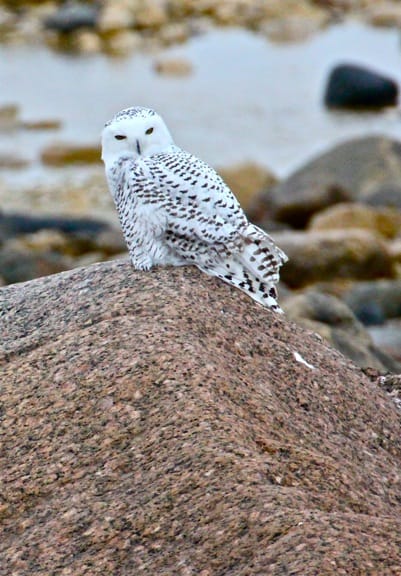
thirteen. SNOWY OWL
Latin Proper name: Bubo scandiacus
Habitat: Arctic tundra in Eurasia and North America
Size: Length twenty.5 to 27.9 in; Weight 3.5 to 5.6 pounds
Diet: Lemmings, ptarmigan, waterfowl, small rodents
Conservation Status: Vulnerable, population decreasing
Now commonly associated with Harry Potter, the Snowy Owl generally prefers marshes and tundra in the Alaskan Arctic and sub-Arctic regions.
But they're increasingly migrating further southward in winter, when their nutrient sources tend to go more scarce.
Growing upward to 27 inches long, these big, beautiful birds are mostly white, but with head, chest, and wings spotted with blackness bars. They're one of the few species of Owls you lot may really get to see hunting during the day.
READ More: Tundra Animals in Churchill, Manitoba
14. TRUMPETER SWAN
Latin Proper noun: Cygnus buccinator
Habitat: Lakes, ponds, rivers, littoral trophy
Size: Length: 54.3 to 62.ii in; Weight: 16.nine to 28 pounds
Diet: Stems, leaves, roots of aquatic plants, insects
Conservation Status: To the lowest degree Business, population increasing
One of two species of swans constitute in Alaska, the Trumpeter Swan is larger than the Tundra Swan, growing to over v feet from pecker-tip to tail.
Both species can be found in all sorts of h2o– lakes, marshes, ponds, and rivers– and both are all-white.
Other than size, the simply piece of cake way to tell them autonomously is their bill (the Tundra Swan's is blackness) and their call. The Trumpeter's is low and distinctively horn-similar, while the Tundra's is loftier and sounds like a "whoop."
READ MORE:20 Longest Rivers in the Globe by Continent
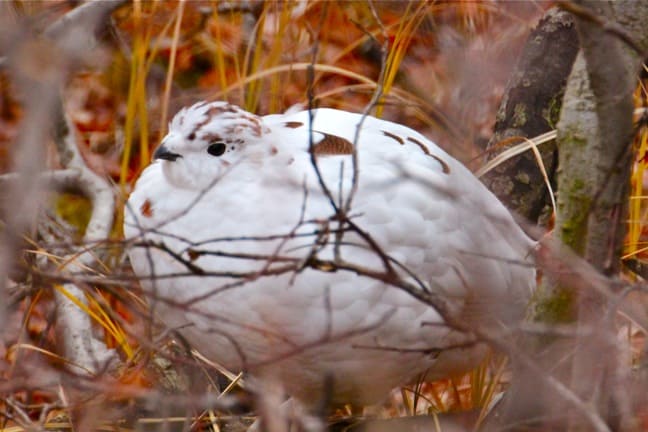
15. WILLOW PTARMIGAN
Latin Name: Lagopus lagopus
Habitat: North American tundras
Size: Length: thirteen.8 to 17.1 in; Weight: 1.2 to 1.47 pounds
Diet: buds, twigs, seeds, leaves
Conservation Status: Least Concern, population decreasing
The official Alaska Land Bird, the Willow Ptarmigan is commonly referred to as a "bush craven," due primarily to the fact that nearly all Alaskan predators (including humans) like to eat them.
Curt and stout, with feathers fifty-fifty on their toes, these birds change colors with the seasons.
Males are reddish brownish and white in summertime, while females are mottled brown, but both plow mostly white in winter to help them stay inconspicuous on the snowy tundra.
I saw this 1 (and many others) during my Denali National Park trip back in 1999.
READ More: A Guide to Upstanding Eating When You lot Travel
ALASKAN BEARS
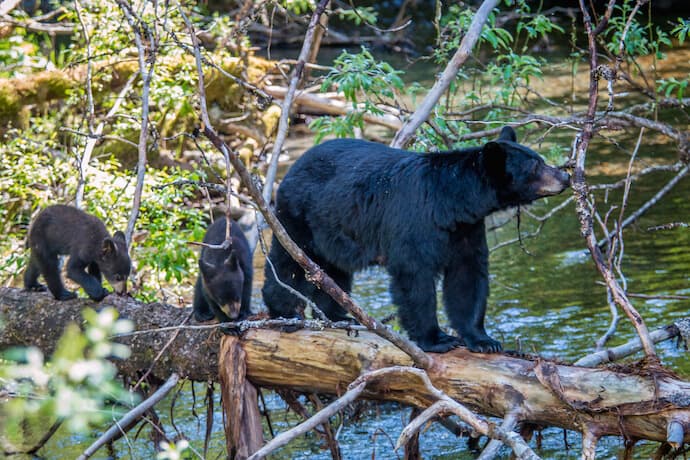
sixteen. BLACK Bear
Latin Proper name: Ursus americanus
Habitat: Coniferous and deciduous forests across North America
Size: Meridian: ii to iii feet Length: 4.2 to 6.25 feet; Weight: 200 to 600 pounds
Nutrition: Grasses, berries, insects, fish
Conservation Status: Least concern, population increasing
Though not quite as big as Brown Bears or Polar Bears, Alaskan Black Bears are an intimidating presence in many of the state'due south forested areas.
Our tour guides frequently advised united states on prophylactic procedures in comport country, including always hiking with a buddy, carrying bear spray, talking loudly and so that you don't surprise them, and never running if yous meet a behave in the woods.
We saw them numerous times during our latest trip to Alaska, including several loners wandering in Kenai Fjords National Park and a mama acquit with two adorable cubs along the Steep Creek Trail at the Mendenhall Glacier.
Despite their proper name, these omnivores tin can actually range in color from black and brown to cinnamon and even shades of bluish (for camouflage near glaciers).
READ MORE: Blackness Bears in Alligator River NWR, North Carolina
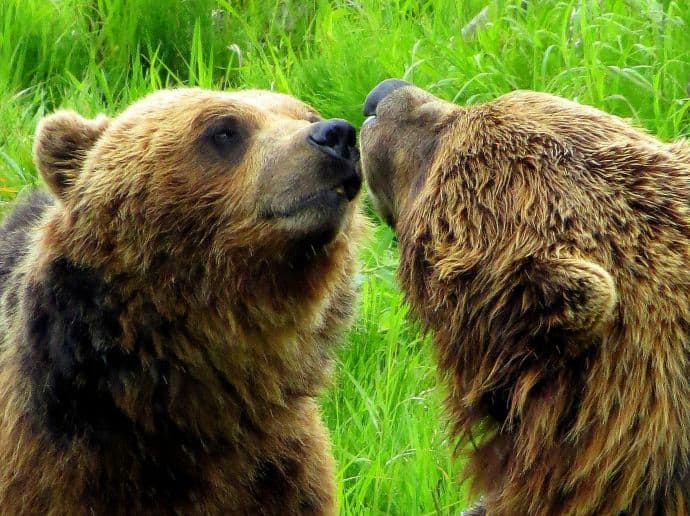
17. BROWN (GRIZZLY) BEAR
Latin Name: Ursus arctos
Habitat: North America tundra, alpine meadows, coastlines, woodlands
Size: Summit: 2.3 to 5 feet; Length: 5 to 7 feet; Weight: 300 to 700 pounds
Nutrition: Grass, berries, basics moose, elk, reptiles, beloved
Conservation Condition: To the lowest degree Concern, population stable
My personal favorite Alaskan creature, Brown Bears are noted for their size (upwardly to 7 feet), humped shoulders, and massive feet with razor-precipitous claws.
There are three subspecies in Brown Bears in Alaska: 1 inhabits coastal areas and feeds generally on salmon, while Grizzly Bears are found inland and farther north (especially Denali National Park) and are smaller due to a more than establish-based diet.
The more isolated Kodiak Island Acquit subspecies is the largest terrestrial carnivore in the world.
READ More:Denali National Park, Alaska (America's Last Frontier)
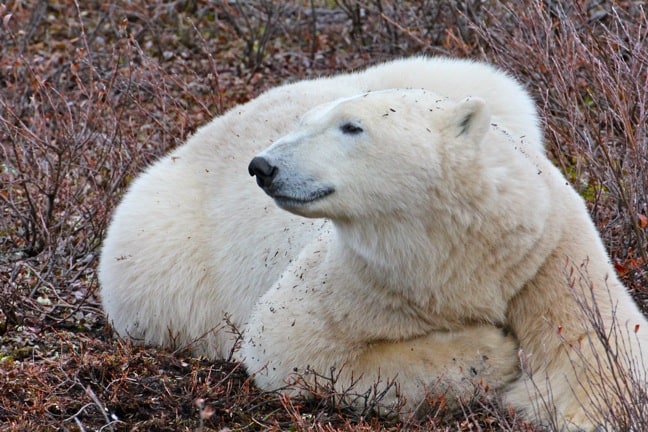
eighteen. POLAR BEAR
Latin Name: Ursus maritimus
Habitat:Arctic coastal areas
Size:Height: four.iv to 7.nine feet; Length 5.nine to nine.8 feet; Weight 900 to 1,600 pounds
Diet:Seals, whale carcasses, walruses, narwhals
Conservation Status: Vulnerable
Polar Bears are technically classified as marine mammals because they spend well-nigh of their lives floating on body of water ice, from which they hunt for Seals and other prey.
Pregnant females create dens and hibernate from November through March, but males are agile all twelvemonth-round.
They're most ofttimes seen on Arctic and sub-Arctic shores in Oct and early Nov, when they're in a land of waking slumber.
Polar Comport fights during this time are frequent and rarely describe blood, only help to establish a hierarchy for feeding and mating rights.
READ MORE: Polar Bear Fight in Churchill, Manitoba
OTHER Country-BASED ALASKAN ANIMALS
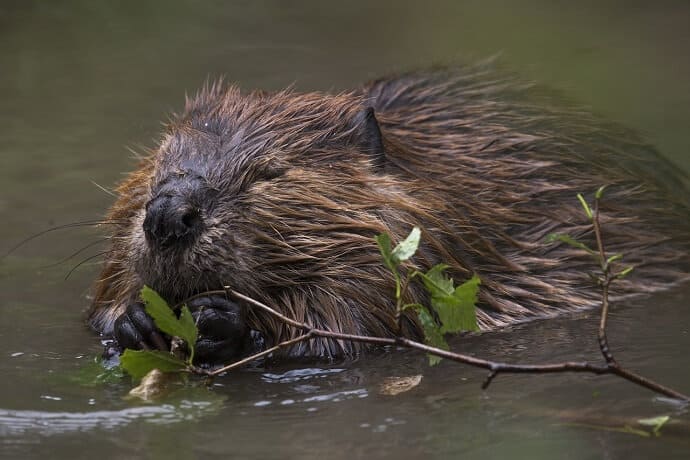
19. AMERICAN BEAVER
Latin Name: Castor canadensis
Habitat: Ponds, lakes, rivers, and streams in the continental Usa
Size: Length: two.four to 3 feet; Weight: 24 to 71 pounds
Diet: Tree bark, roots, leaves, wetlands plants
Conservation Status: To the lowest degree Business organisation, population stable
While you may not really spot an Alaskan Beaver during your visit, you'll virtually certainly see their handiwork if you go rafting, canoeing, or kayaking down any major river or stream.
These large (up to four anxiety long), brown rodents employ their remarkable teeth to fell trees into the water, gradually edifice elaborate dams.
They're most agile at dawn and sunset, when they emerge to feed on aquatic plants, bark, and grass, slapping their tails on the water as a alarm if danger is imminent.
READ MORE:The 10 Best Canoe Trips (World Trael Bucket List)
20. ARCTIC Fox
Latin Name: Vulpes lagopus
Habitat: Chill and alpine tundra
Size: Height nine.eight to 12 in; Length 2.3 to iii.six anxiety; Weight: iii.1 to 21 pounds
Diet: Lemmings, rodents, fish, birds, eggs, seaweed
Conservation Condition: Least Concern, population stable
Smaller than their red cousins, Arctic Foxes are perfectly adjusted to their frigid habitat (which ranges from Alaska and Chill Canada to Russian federation and Scandinavia ).
They have stout piddling bodies, stubby appendages, and remarkably thick fur.
They also boast forrad-facing ears that aid them chase by hearing prey (including birds, hares, lemmings, and squirrels) under the snow.
When they leap high in the air and pounce through the snowfall, information technology'due south an artfully acrobatic feat you'll never forget.
READ MORE: Astonishing Brute Facts (Animate being Olympians)
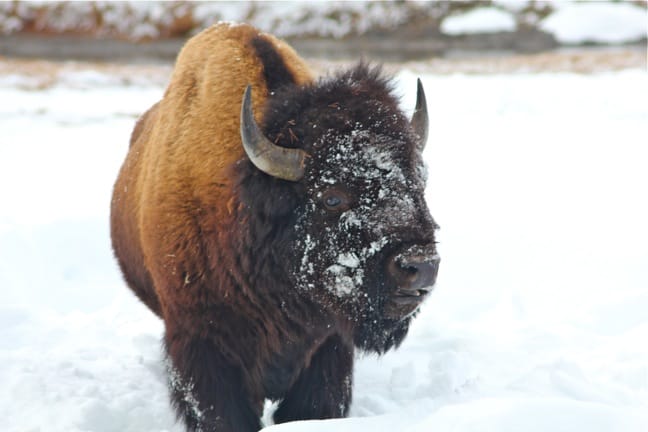
21. BISON
Latin Name: Bison bison
Habitat: River valleys, prairies, grasslands
Size: Height: 5.5 to 6.five feet; Length: 9 to 12.five feet; Weight; 1,800 to 2,400 pounds
Diet: Grasses, flowering plants, lichens, woody plant leaves
Conservation Condition: Near threatened
Most people associate Bison (which are confused with, but technically not a species of Buffalo) with Yellowstone National Park and parts of Canada.
But the species was introduced to Alaska back in 1928, and there are now several dissimilar herds in the state that number in the hundreds.
The earth's largest terrestrial mammal, male Bison in Alaska can counterbalance more than a ton. They're typically seen grazing in meadows, open woodlands, and river valleys.
READ More than:10 Best National Parks in USA for Wildlife Watching
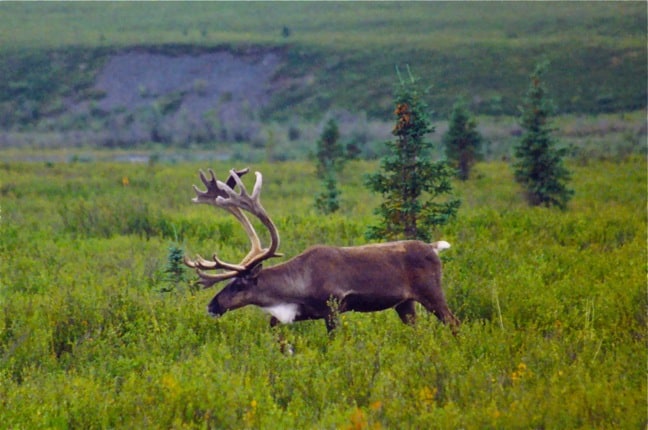
22. CARIBOU
Latin Proper name: Rangifer tarandus
Habitat: Arctic tundra and boreal forests
Size: Height: 2.eight to iv.9 feet; Length 5.three to 7 feet; Weight 180 to 400 pounds
Diet: Lichen, mosses, herbs, ferns, grasses
Conservation Status: Vulnerable, population decreasing
Caribou in Alaska, which are as well known every bit Reindeer , are easily identified by their large antlers (which abound on both sexes), shaggy neck fur, and lite rump patches.
They were originally introduced to the area every bit a nutrient source during the 19th century gold rush. Now they're found in the state'south forests and tundra, where their huge hooves help them notice solid footing on ice and snowfall.
There are more than a million Reindeer in Alaska, where herds numbering up to 350,000 animals migrate 900+ miles from where they calve in summertime to warmer areas in winter.
READ More than:Winter Adventures in Finnish Lapland
23. DALL SHEEP
Latin Name:Ovis dalli
Habitat: Meadows, steep slopes, tall areas in the subarctic mountain ranges of Alaska
Size: Length: 3.5 to 4.half-dozen anxiety; Weight: up to 300 pounds
Diet: Grasses, broad-leaved plants, sedges, willows
Conservation Status: To the lowest degree Concern, population stable
As with the Caribou, both male and female Dall Sheep have horns. But the male's are considerably more massive and coiled.
They often implement them for intense head-butting competitions, which are used to establish a hierarchy of dominance for mating purposes.
Dall Sheep in Alaska are typically seen on cliff edges in mountainous regions, where their white coats stand out in hitting dissimilarity to the dynamic green and grey landscapes.
READ MORE:20 All-time Mountains in the Globe
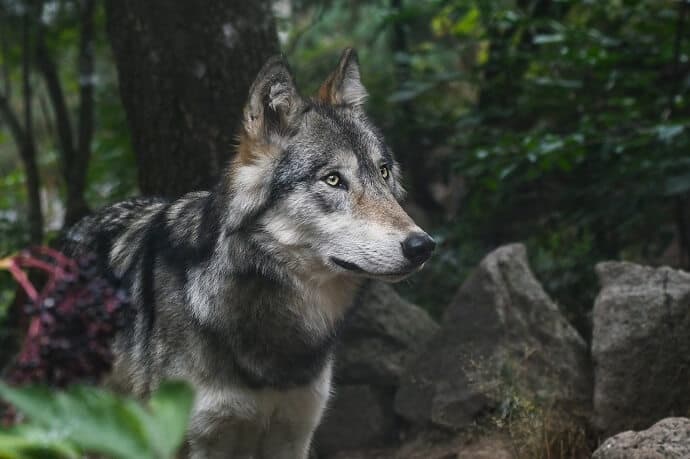
24. GRAY WOLF
Latin Name: Canis lupus
Habitat: Tundra, forests, grasslands
Size: Pinnacle: 2.ii to 2.7 feet; Length: 3.9 to half dozen.6 anxiety; Weight 51 to 180 pounds
Nutrition: Deer, elk, bison, moose, beavers, rabbits
Conservation Status: Least Business organisation, population stable
Hands the largest of Alaska's canine species, the Gray Wolf tin can grow to six feet and comes in colors ranging from white to black and all shades in between.
They're institute in approximately 85% of the state's wilderness areas, living in packs of two to 30 animals.
The Wolf is i of the most difficult species of wildlife in Alaska to run across, simply I lucked into having one emerge from the forest correct by our shuttle coach through Denali National Park. Information technology was a magical, but VERY brief, feel!
READ MORE: Endangered Species that Mate for Life
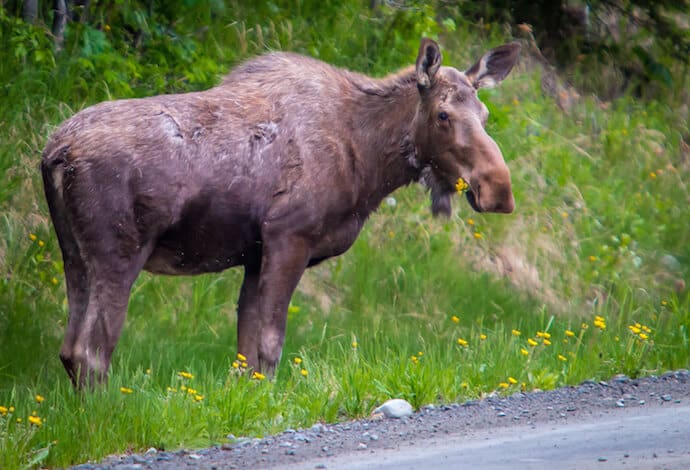
25. MOOSE
Latin Name: Alces alces
Habitat: Northern regions of the United States, forested areas with streams and ponds
Size: Height: 4.half dozen to six.nine feet; Length: 7.9 to ten anxiety; Weight: 440 to 790 pounds
Diet: Leaves, twigs, shrubs, bark
Conservation Condition: Least Business, population increasing
I call the Alaskan Moose "the Camels of the tundra," because they tend to be of a similar size (upward to 9 feet tall), body type (huge, with long, thin legs and a pendulous snout), and disposition (ornery and unpredictable).
The Moose is the official Alaska State animal. But near Alaskans we met were fifty-fifty more than wary of Moose than Bears.
They tend to be found in forests nigh shallow water sources, but nosotros saw a female in the Kenai National Wildlife Refuge correct alongside the road, feeding on dandelions.
Females with immature calves are extremely aggressive, and should exist avoided at all costs.
READ More than:The Moose Whisperer & The Coolest Moose in Sweden

26. Mount GOAT
Latin Name: Oreamnos americanus
Habitat: Alpine regions of North America
Size: Height: up to iii.5 feet; Length: 4.75 to 5.eight feet; Weight: 100 to 300 pounds
Diet: Grasses, lichens, herbs, mosses, ferns
Conservation Condition: To the lowest degree business organization, population stable
From a altitude (which is usually how you'll see them) you might fault a Mountain Goat in Alaska for a Dall Sheep, since both are white, abound upwards to 6 feet, and prefer mountainous areas.
But the goat has longer, shaggier fur and short, straight blackness horns. They prefer high tall meadows in summer, merely going down towards the tree line in winter.
Nosotros spotted quite a few in the hills of Kenai Fjords National Park and Glacier Bay National Park'southward Gloomy Knob area, including this mama goat with a baby climbing on her.
READ More than: 40 Facts Nearly the Markhor (National Animate being of Pakistan)
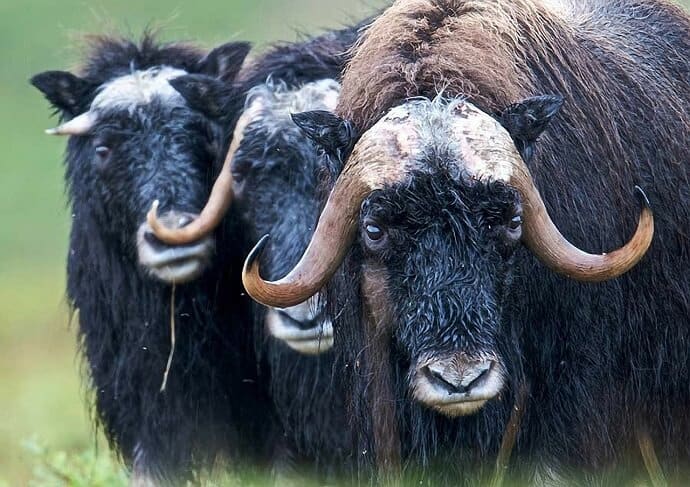
27. MUSKOX
Latin Name: Ovibos moschatus
Habitat: Chill tundra
Size: Tiptop: 4 to 5 anxiety; Length: iv.iv to 8.2 feet; Weight: 500 to 800 pounds
Diet: Mosses, lichens, roots, grasses
Conservation Status: To the lowest degree Concern, population stable
Large and stocky, with long hair and prominent horns, these imposing moo-cow-like creatures grow up to eight feet.
Though the native Muskox population in Alaska was hunted to extinction in the 1800s, a herd was introduced from Greenland in the 1930s.
Today in that location are thousands of Muskox in Alaska, including a domesticated farm in Palmer, a research project at the University of Alaska in Fairbanks, and wild herds roaming in western areas such every bit Bethel and Nome.
READ MORE: Alaska Wild animals Conservation Center (Photo Gallery)

28. Carmine SQUIRREL
Latin Name: Tamiasciurus hudsonicus
Habitat: Broadleaf and coniferous forests
Size: Length: 11 to 14 in; Weight: 7 to 18 oz
Nutrition: Seeds, nuts, bawl, insects, fruits
Conservation Status: Least Concern, population stable
A mutual sighting in Alaska's forests, the Red Squirrel is actually a rusty olive colour with a white belly and a fluffy reddish-orange tail.
You'll likely hear their noisy chatter earlier y'all see them scurrying quickly through the forest to get together their winter supply of berries, nuts, and seeds.
Look for burrows around the base of trees, where they typically hide their cache of food.
READ More than: The twenty Biggest Forests in the Earth
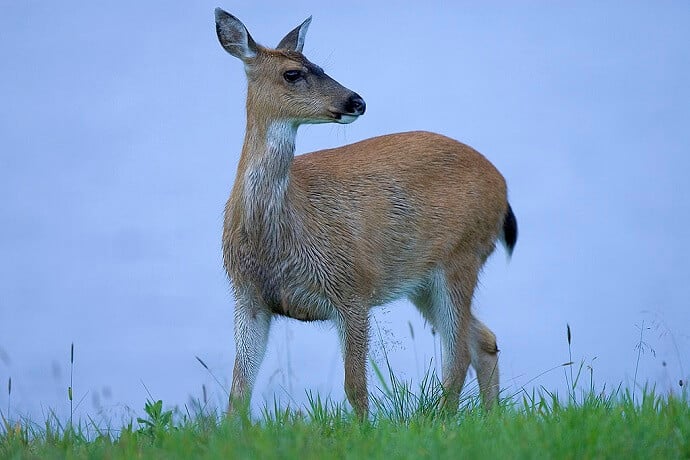
29. SITKA BLACK-TAILED DEER
Latin Proper noun: Odocoileus hemionus sitkensis
Habitat: Wet coastal rainforests of Southeast Alaska and north-coastal British Colombia
Size: Height: four to v feet; Weight: 80 to 120 pounds
Diet: Leaves, shrubs, stems of woody plants
Conservation Condition: Data scarce
Institute primarily in the coastal rainforests of southern Alaska, the Sitka Black-tailed Deer is relatively small, averaging nether five feet tall.
The species changes in coloration to help them stay camouflaged, from carmine-brown coats in summertime to gray in winter.
Males shed their antlers annually between January and March.
READ More: 40 Fascinating Facts Near the Saola (a.k.a. Asian Unicorn)
ALASKAN WHALES & PORPOISES
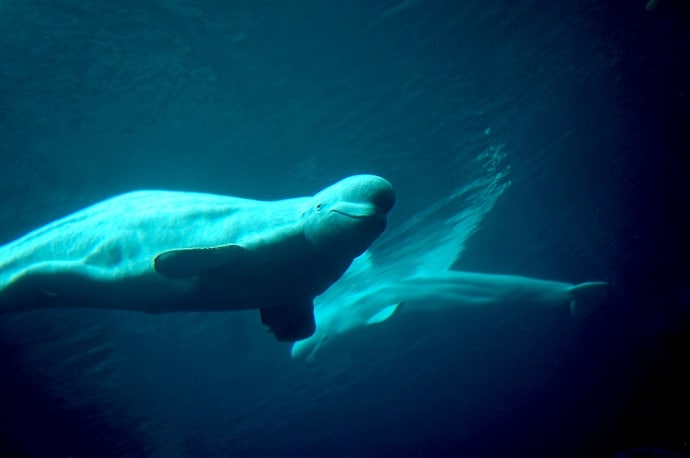
30. BELUGA WHALE
Latin Name: Delphinapterus leucas
Habitat: Chill and subarctic waters
Size: Length 13 to xx feet; Weight two,000 to iii,000 pounds
Diet: Fish, crustaceans, worms
Conservation Status: To the lowest degree Concern
Usually establish in littoral waters and shallow bays, this small (around 13 feet long on boilerplate) white whale has a pronounced forehead filled with fat tissue (called the melon).
The Beluga Whale is likewise known every bit the "body of water canary" because of its distinctive high-pitched squeaks, squeals, and whistles, which information technology uses to find prey and communicate with others.
The subpopulation of Alaska'due south Cook Inlet is considered endangered, and is currently protected under the U.S. Endangered Species Act.
READ More than: North Atlantic Correct Whale Facts

31. BOWHEAD WHALE
Latin Name: Balaena mysticetus
Habitat: Chill and subarctic waters
Size: Length 49 to 59 feet; Weight: up to 220,500 pounds
Diet: Plankton, copepods, euphausiids
Conservation Condition: Least Concern, population increasing
Although we never saw a Bowhead Whale during our two weeks in Southeast Alaska, the species deserves special mention as Alaska's Country Marine Mammal.
They earned this distinction because they're the only whales in Alaska that spend their unabridged life in Chill waters. Bowhead Whales take also historically been an important food source for the indigenous people of Alaska's northwestern coastal communities.
Growing up to 60 anxiety long, Bowheads have an unusual arched jaw and a oral fissure/head that can be up to 1/3 of their full body length.
READ More: 40 Fascinating Facts About Blueish Whales
32. DALL'S PORPOISE
Latin Name: Phocoenoides dalli
Habitat: North Pacific Body of water
Size: Length: vi.5 to seven.5 feet; Weight: 230 to 270 pounds
Nutrition: Small schooling fish, cephalopods, crustaceans
Conservation Status: Least Concern
1 of two kinds of porpoise we saw in Alaska (the other existence the more dull-colored Harbor Porpoise), the Dall'south Porpoise looks a bit like a tiny (7-foot-long) Killer Whale.
Information technology has a shorter snout and a stockier torso than a dolphin, with black coloring offset by a big white belly patch.
They usually travel in pods ranging from two to 20 animals, and are fond of playing in the wake of ships (which is where nosotros saw them during our Inside Passage prowl).
READ More than:15 Harmful Traditions & Cultural Practices
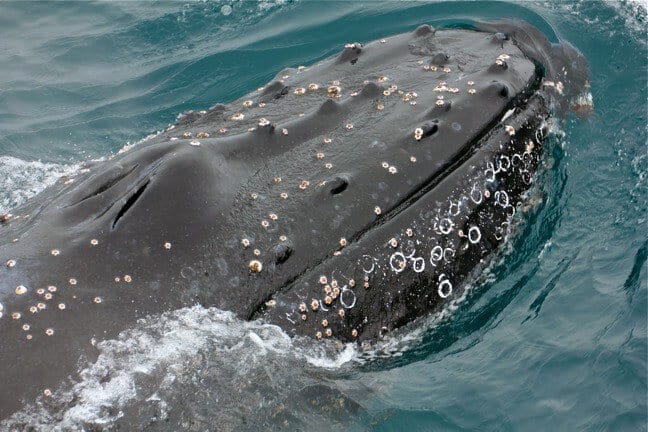
33. HUMPBACK WHALE
Latin Proper noun: Megaptera novaeangliae
Habitat: All major oceans (except polar seas) in open and shallow coastline waters
Size: Length 48 to 62.5 anxiety; Weight 80,000 pounds
Diet: Krill, plankton, small-scale fish
Conservation Status: Least Business organization, population increasing
These gentle giants (which can grow up to 50 feet long) are oft seen close to shore forth Alaska'southward southern coast during their summer migration season.
You usually only get glimpses of their humped backs and small dorsal fins as they dive to feed on small schooling fish. But every and so often one volition prove you their long flippers or tail flukes, which are normally white.
Despite many whale watching tours, I've but ever seen them breach from a altitude. Listen for their haunting calls when the water is calm.
READ More: Whales That Live in Antarctica
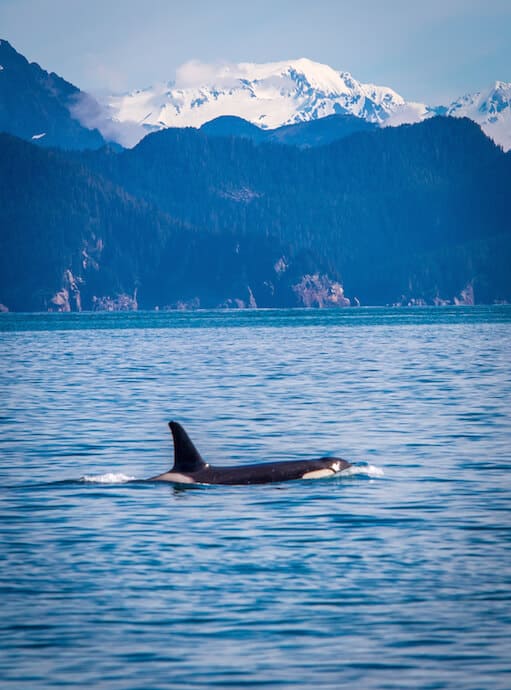
34. Orca (a.k.a. Killer Whale)
Latin Name: Orcinus orca
Habitat: All major oceans
Size: Length 23 to 32 feet; Weight 12,000 pounds
Diet: Fish, penguins, seals, sea lions, whales
Conservation Condition: Information deficient
Though they're commonly known equally the Killer Whale, Orcas are non actually a whale at all, but a member of the dolphin family.
The "killer" part comes from the fact that pods of up to 40 Orcas volition hunt large marine animals equally a pack, virtually like "sea wolves."
With their long black dorsal fins and white-spotted eyes and bellies, Orcas in Alaska are a fairly common sight in Kenai Fjords National Park, the Inside Passage, and other Alaskan waters.
READ More:Southern Resident Killer Whales
OTHER ALASKAN MARINE ANIMALS
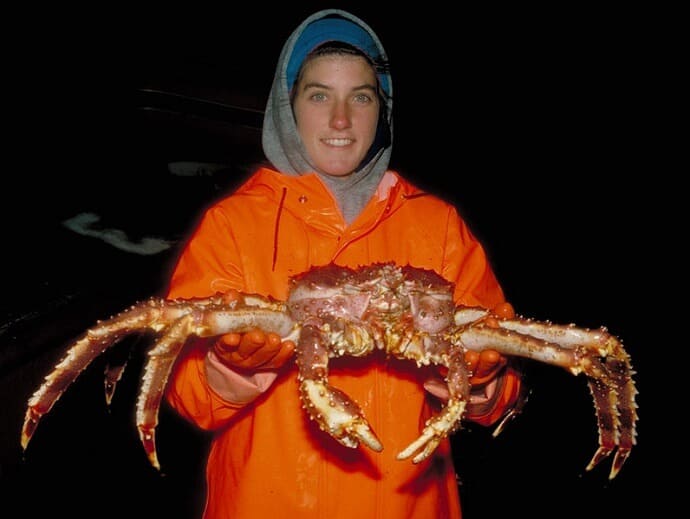
35. ALASKAN KING CRAB
Latin Name: Paralithodes camtschaticus
Habitat: Shallow coastal waters off of southwestern Alaska
Size: Length: 4.ix five.9 feet; Weight: half-dozen to 10 pounds
Diet: Clams, worms, sponges, algae,
Conservation Status: Information Deficient
2d just to Sockeye Salmon among the state's near valuable commercial species, the Alaskan Male monarch Crab lives up to its name by growing up to a whopping five feet broad.
Typically plant in waters upwardly to 200 feet deep, these big cerise wonders have pointy spikes roofing almost of their heads, six legs, and claws.
The right hook is usually much larger on adult crabs, and often used as a weapon during fights. Their meat is widely considered a effeminateness , and oftentimes sells for $30-$40 per pound.
READ MORE:lx Weird Animals Around the Earth

36. HARBOR SEAL
Latin Name: Phoca vitulina
Habitat: Coastal Atlantic and Pacific Waters
Size: Length 4.9 to half-dozen.2 feet; Weight: up to 375 pounds
Nutrition: Fish, shellfish, crustaceans
Conservation Status: Least Concern
I of the most difficult species of wildlife in Alaska to photograph, Harbor Seals (a.k.a. Leopard Seals, due to their spotted coats) are shy but plentiful.
We saw many of them throughout the Within Passage, Glacier Bay, and Kenai Fjords, particularly around icebergs and "berglets" (as National Park Ranger Rebekah Weirda liked to telephone call them).
They're easiest to meet on the ice floes, where they go to rest and bear their immature away from the watchful optics of predators.
READ MORE:30 Antarctic Animals Y'all Can Run into on an Antarctica Cruise
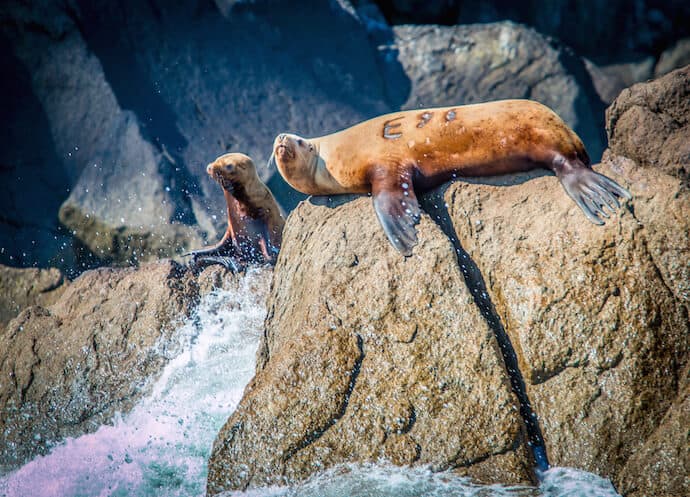
37. STELLER'S Bounding main LION
Latin Proper noun: Eumetopias jubatus
Habitat: Littoral waters of the North Pacific Ocean
Size: Length: 7.75 to 9.25 anxiety; Weight: 1,000 to 2,500 pounds
Diet: Fish, octopus, squids
Conservation Condition: Near Threatened, population increasing
Also known every bit Northern Sea Lions, these pinnipeds tin grow to ten.5 feet long and counterbalance 1000+ pounds, with males up to iii times equally large as females.
Around 70% of these endangered animals inhabit the waters around Alaska, gathering seasonally to breed and raise pups in rookeries used year afterwards year.
We saw several Steller'south Sea Lions in Kenai Fjords National Park that had been tagged as part of a scientific report on their declining population numbers.
READ MORE: Swimming with Body of water Lions (Galapagos Islands)
38. SALMON
Latin Proper name: Oncorhynchus nerka
Habitat: Fresh h2o streams, lakes and estuaries
Size: Length: 18 to 31 inches; Weight: iv to 15 pounds
Diet: Plankton, squid, eels, shrimp
Conservation Status: To the lowest degree Concern, population stable
Alaskan Salmon is non only the land's #i commercial export, but they're also a huge tourism describe in one case angling flavor opens.
Nosotros heard tales of the Kenai River being lined with hundreds of fishermen standing shoulder-to-shoulder during peak season, occasionally competing with the bears for their catch.
In addition to Sockeye (or Blood-red Salmon), Chinook (King Salmon), Coho (Silver Salmon), and Pinkish (Humpbacked) Alaskan Salmon are besides pop.
READ MORE: Fishing Mobile Bay & the Mobile-Tensaw Delta
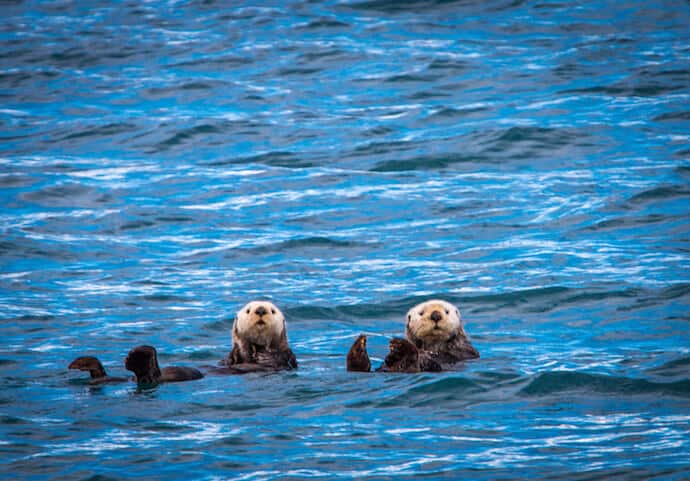
39. SEA OTTER
Latin Proper name: Enhydra lutis
Habitat: Coasts of the Pacific Ocean in North America and Asia
Size: Length: iii.three to 4.9 feet; Weight: 31 to 99 pounds
Diet: Clams, mussels, sea urchins, snails
Conservation Condition: Endangered, population decreasing
Although they may look cute and small from a altitude, these ambrosial Alaskan animals can actually abound to reach 6 feet long and more than 70 pounds.
Unlike its cousin, the Northern River Otter, the Sea Otter only inhabits saltwater (preferably kelp beds shut to rocky coastlines).
About of the Sea Otters we spotted were lying on their backs, eating, sleeping, or carrying their young. They're also known to use stones to crack open up the Sea Urchins and shellfish on which they feed.
READ More than: Hairy-Nosed Otter (Endangered Species)
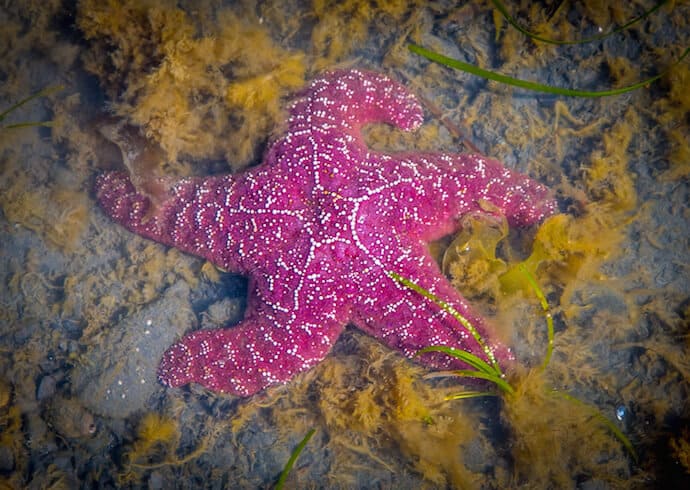
40. Ocean STARS
Latin Name: Asteroidea
Habitat: Tidepools, coral reefs, and deep sea of all oceans
Size: Length: 5 to 10 inches; Weight: up to 11 pounds
Nutrition: Mollusks, clams, oysters, mussels
Conservation Status: Data deficient
We learned merely how many dissimilar types of Ocean Stars (a.k.a. Starfish) there are in Alaska during a walk along the shore of Kenai Fjords National Park at low tide.
The Bat Star was my favorite: Growing upwardly to 10 inches, with short arms and broad bodies, Bat Stars range in color from white to vibrant orange and red.
My daughter loved the hit patterns of the Ochre Body of water Stars pictures above, which are a common sight in tide pools and range from yellow and orange to purple and brown. –Bret Honey; photos past Allie Beloved & Bret Beloved unless otherwise noted
Our trip to Alaska was partly hosted by AdventureSmith Explorations. But our opinions remain our own, and we will never compromise our integrity to our readers. To learn more about planning an Alaskan Vacation, contact AdventureSmith Explorations at 877-720-2875 or travel@adventuresmithexplorations.com.
Source: https://greenglobaltravel.com/alaskan-animals-species/
Posted by: aguilaronoten.blogspot.com

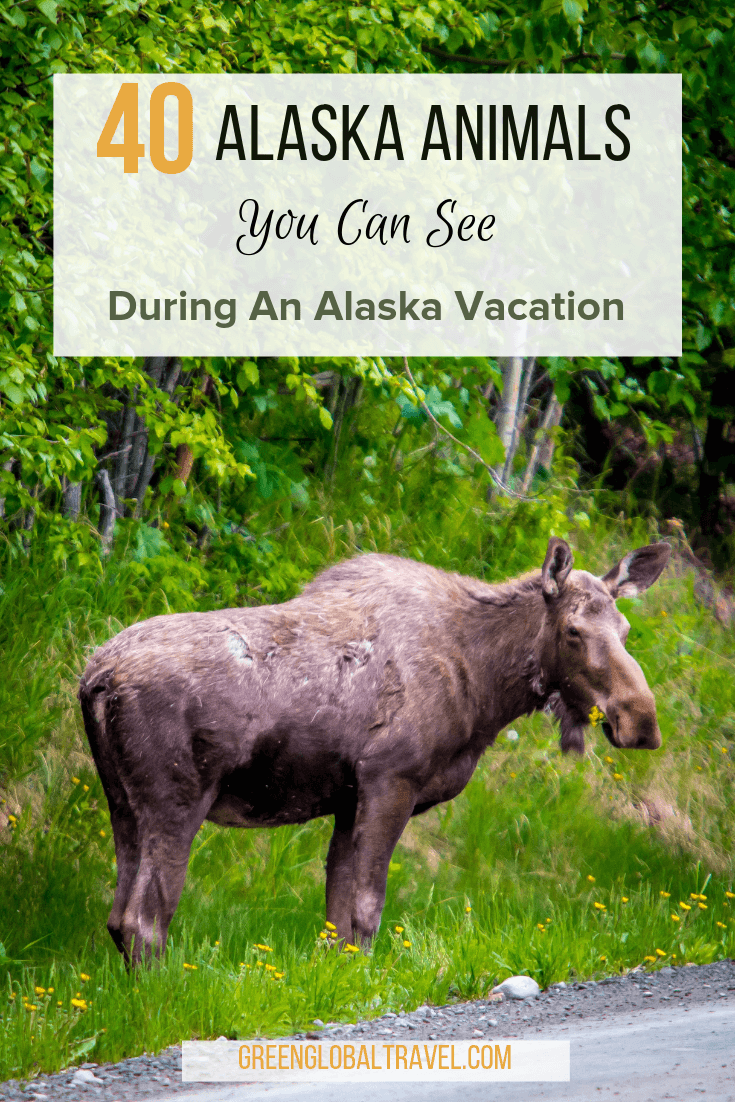

0 Response to "What Are The Major Plants And Animals Are In Fairbanks"
Post a Comment